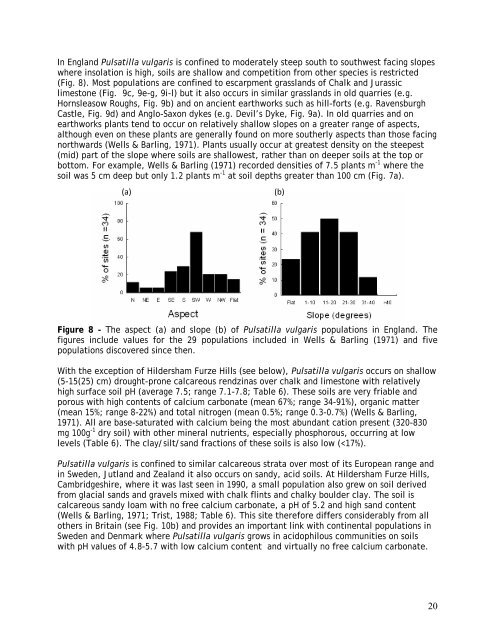Pulsatilla vulgaris (L.) Mill. - Plantlife
Pulsatilla vulgaris (L.) Mill. - Plantlife
Pulsatilla vulgaris (L.) Mill. - Plantlife
You also want an ePaper? Increase the reach of your titles
YUMPU automatically turns print PDFs into web optimized ePapers that Google loves.
In England <strong>Pulsatilla</strong> <strong>vulgaris</strong> is confined to moderately steep south to southwest facing slopes<br />
where insolation is high, soils are shallow and competition from other species is restricted<br />
(Fig. 8). Most populations are confined to escarpment grasslands of Chalk and Jurassic<br />
limestone (Fig. 9c, 9e-g, 9i-l) but it also occurs in similar grasslands in old quarries (e.g.<br />
Hornsleasow Roughs, Fig. 9b) and on ancient earthworks such as hill-forts (e.g. Ravensburgh<br />
Castle, Fig. 9d) and Anglo-Saxon dykes (e.g. Devil’s Dyke, Fig. 9a). In old quarries and on<br />
earthworks plants tend to occur on relatively shallow slopes on a greater range of aspects,<br />
although even on these plants are generally found on more southerly aspects than those facing<br />
northwards (Wells & Barling, 1971). Plants usually occur at greatest density on the steepest<br />
(mid) part of the slope where soils are shallowest, rather than on deeper soils at the top or<br />
bottom. For example, Wells & Barling (1971) recorded densities of 7.5 plants m -1 where the<br />
soil was 5 cm deep but only 1.2 plants m -1 at soil depths greater than 100 cm (Fig. 7a).<br />
(a) (b)<br />
Figure 8 – The aspect (a) and slope (b) of <strong>Pulsatilla</strong> <strong>vulgaris</strong> populations in England. The<br />
figures include values for the 29 populations included in Wells & Barling (1971) and five<br />
populations discovered since then.<br />
With the exception of Hildersham Furze Hills (see below), <strong>Pulsatilla</strong> <strong>vulgaris</strong> occurs on shallow<br />
(5-15(25) cm) drought-prone calcareous rendzinas over chalk and limestone with relatively<br />
high surface soil pH (average 7.5; range 7.1-7.8; Table 6). These soils are very friable and<br />
porous with high contents of calcium carbonate (mean 67%; range 34-91%), organic matter<br />
(mean 15%; range 8-22%) and total nitrogen (mean 0.5%; range 0.3-0.7%) (Wells & Barling,<br />
1971). All are base-saturated with calcium being the most abundant cation present (320-830<br />
mg 100g -1 dry soil) with other mineral nutrients, especially phosphorous, occurring at low<br />
levels (Table 6). The clay/silt/sand fractions of these soils is also low (

















